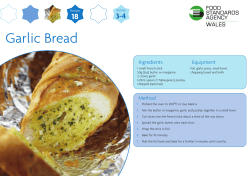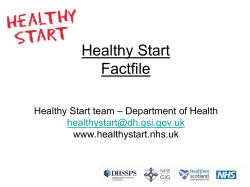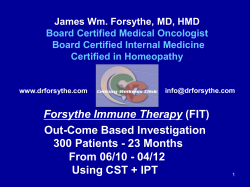
Vitamin D and Winter Well-Being
B4 Health · The Epoch Times· December 11 - 17, 2006 Vitamin D and Winter Well-Being What’s Your Grade? By Dr. JOHN BRIFFA Special to The Epoch Times Contracted days come as part and parcel of this time of year and leave us short on sunlight. One important effect of sunshine is that it drives the body’s production of vitamin D—a key nutrient. A combination of wrapping up for winter and a dearth of sunlight can leave us low in vitamin D. So what can be done to ensure we keep levels of this nutrient up at this time of year? Besides sunlight, the other major source of vitamin D is our diet. Cod liver oil is a significant source of vitamin D. For more than a hundred years, taking cod liver oil has been advocated for its ability to ward off rickets and to ease stiff and creaking joints. The ability of cod liver oil to supply the body with vitamin D may have important implications for both body and brain. For instance, there is evidence from both test-tube and animal experiments that shows vitamin D has the ability to reduce the risk of the development and spread of cancerous tumors. Not surprisingly, studies show that increased sunlight exposure is associated with a decreased risk of several forms of cancer, including those of the breast, prostate, and colon. Vitamin D is also crucial for bone health and seems to help protect against multiple sclerosis. Some research suggests that vitamin D deficiency may play a part in seasonal affective disorder (SAD) —sometimes referred to as “winter blues.” In one study, just five days of treatment with vitamin D (at a dose of 400 or 800 IU per day) was found to improve winter mood [1]. Further evidence for the potential for vitamin D to alleviate SAD came from research in which individuals were treated with either 600 or 4,000 IU of vitamin D each day for at least six months. Both dosages of vitamin D led to improvements in the participants’ mood and general well-being, with those on the higher dose of vitamin D benefiting the most [2]. Cod liver oil, like other fish oils, is also rich in omega-3 fats. These come in two main forms: docosahexaenoic acid (DHA) and eicosapentaenoic acid (EPA). A high consumption of these fats has been linked with a reduced risk of cardiovascular conditions such as heart attack and stroke. Omega-3 fats have a natural anti-inflammatory effect in the body, and there is some thought that this biochemical benefit may be part of the explanation for why cod liver oil can provide relief from conditions like osteoarthritis and rheumatoid arthritis. And like vitamin D, these fats also have benefits for the brain. DHA appears to be important for the structural integrity of the brain, while EPA seems to have a more important role in the day-to-day running of the brain. Omega-3 fats show promise in the prevention and/or treatment of many mental ailments, including depression and dementia. To get reasonable levels of vitamin D and omega-3 fats from cod liver oil, one needs to take 1 to 2 teaspoons a day throughout the winter. Fortunately, cod liver oils that have been naturally flavored (often with Pass or Fail? By W. GIFFORD-JONES, M.D. What have you learned from this column during the past year? I hope I’ve been a good teacher and you pass this test with at least 50 percent of the questions right. But don’t get depressed if you flunk the test. I’m not going to tell anyone! And it may even help you when playing Trivial Pursuit. Louise Valentine/The Epoch Times VITAMIN D SOURCE: Cod liver oil is especially helpful in the winter in the more northern latitudes, where vitamin D from sunlight is already diminished. lemon or orange) are now available and represent a good option for those who do not like the taste of plain cod liver oil. References: 1. Lansdowne, A.T., et al. Vitamin D3 enhances mood in healthy subjects during winter. Psychopharmacology (Berlin) 1998; 135(4): 319–23. 2. Vieth, R., et al. Randomized comparison of the effects of the vita- min D3 adequate intake versus 100 mcg (4000 IU) per day on biochemical responses and the wellbeing of patients. Nutrition Journal 2004; 3:8 http://www.nutritionj.com/content/3/1/8 Dr John Briffa is a London-based doctor, author, and health writer with an interest in nutrition and natural medicine. His website is www.drbriffa.com Pancreatic Cancer Linked to Sugar Intake Photos.com SUGAR: Consumption of sugar has been associated with an increased incidence of pancreatic cancer. NEW YORK (Reuters Health)— Eating lots of sugar and sugar-sweetened foods could increase a person’s likelihood of developing cancer of the pancreas, by far one of the deadliest types of cancer, Swedish researchers report. Dr. Susanna C. Larsson of the Karolinska Institute in Stockholm and her colleagues found that pancreatic cancer was significantly more likely to strike men and women who added the most sugar to their food and consumed the greatest quantities of soft drinks. The researchers followed 77,797 men and women aged 45 to 83 for an average of about seven years. Those who reported eating five or more servings of added sugar daily, for example sugar added to tea, coffee, or cereal, were 69 percent more likely to develop pancreatic cancer than those who never added sugar to their food or drink. People who consumed two or more servings of soft drinks a day had a 93 percent greater risk of pancreatic cancer compared to those who abstained from these beverages. Eating sweetened fruit soups or stewed fruit increased risk by 51 percent. But there was no association between sweets, marmalade, or jams and pancreatic cancer risk, possibly because these foods are eaten less frequently and in smaller quantities, Larsson and her colleagues write. Factors involved in the loss of sensitivity to the blood-sugar processing hormone insulin, such as sedentary lifestyle, obesity, and diabetes, have all been tied directly to pancreatic cancer, a disease that kills the vast majority of people diagnosed within five years, Larsson and her team note in the American Journal of Clinical Nutrition. Eating too much sugar could therefore conceivably boost pancreatic cancer risk by putting greater demands on the pancreas to produce insulin while reducing sensitivity to the hormone, as well as through a number of other potential mechanisms. “Given the ... implications of these findings and the poor prognosis of pancreatic cancer, further research on sugar and high-sugar foods ... is warranted,” the researchers conclude. Source: American Journal of Clinical Nutrition, November 2006 NEW YORK (Reuters Health)— People who flavor their diets with plenty of onions and garlic might have lower odds of several types of cancer, a new study suggests. In an analysis of eight studies from Italy and Switzerland, researchers found that older adults with the highest onion and garlic intakes had the lowest risks of a number of cancers— including colon, ovarian, and throat cancers. The findings, which appear in the American Journal of Clinical Nutrition, are in line with some past research. But those studies were mainly conducted in China, and it is unclear if the results are different in Western countries. Dietary habits are substantially different in China, with garlic intake, in particular, being far higher, Dr. Carlotta Galeone, the lead author of the new study, told Reuters Health. Dr. John Cui, Ph.D. Board Acupuncturist N.Y.S. License 25 yrs experience *Actual case reported in Lutheran Medical Center, NY Specialty: Allergies & asthma, arthritis, anxiety, depression, diabetes, dysmenorrheal, endocrine disorders, gout, infertility, menopause syndrome, neurological disorders, pain & migraine, prostatitis, quit smoking, stroke, stress, uterine fibroid, wrinkles reduction. 82-51 51st Avenue Elmhurst, NY 11373 Dr. Gifford-Jones is a medical journalist with a private medical practice in Toronto. Onions and Garlic Antidepressants Keep Cancer Away Raise Suicide Risk in Young Adults Spinal-cord injury patient was able to walk following scalp acupuncture* 250 W. 57th Street #1003 New York, NY 10107 The first 10 questions are true, the rest false. Photos.com Stroke patient stands up immediately Tel: 212-683-9891 / 718-672-1328 1. Men who don’t shave daily enjoy less sex and are more likely to suffer a stroke and heart attack. 2. Abdominal hernias are repaired to decrease the risk of strangulation of the bowel. But recent studies show that there is no need to operate on all hernias. 3. A waistline of more than 40 inches (100 centimeters) for a man and 35 inches (90 centimeters) for a woman is a risk factor for heart disease. 4. Seventy-five percent of cases of sudden death during sexual activity occur in those involved in extramarital sex. 5. Men with high levels of lead in their bones have three times the risk of developing cataracts and are twice as likely to have hypertension. 6. Leeches can be helpful in treating post-operative complications when a severed limb has been rejoined and excessive swelling threatens to decrease the flow of oxygenated blood to the extremity. 7. Magnesium is a natural antispasmodic and can help to ease the pain of angina and decrease the risk of an abnormal heart rate. 8. The kinetic energy of a rotating power blade of a lawnmower has three times the muzzle energy of a .357 Magnum pistol and can cause serious eye injury. 9. Low-intensity laser therapy can ease the pain of arthritis and herniated lumbar disks, and heal diabetic ulcers. 10. The diagnosis of depression is often missed in more males than females due to their macho image. 11. Older drivers can adapt to night driving as well as younger drivers as long as they take vitamin E. 12. It’s not possible to catch herpes by sitting down on a public toilet seat as the virus is quickly killed on exposure to the air. 13. You only require 10 grams of dietary fiber daily to ensure soft bowel movements and decrease the risk of developing hernias of the large bowel. 14. High doses of vitamin C increase the risk of cataracts, arthritis, and kidney stones. 15. X-rays are far superior to colonoscopy in diagnosing cancer of the large bowel. 16. Mitral valve prolapse is a serious heart condition that always requires surgery. 17. A short afternoon nap does not increase mental and physical performance. 18. Studies show that the worst time to have a surgical operation is Tuesday morning at 8:00 am. The best time is Monday morning. 19. Women experience the same symptoms of heart attack as men. And the results of bypass surgery are just as good as those for men. 20. Headache is more often the result of white wine that contains 200X more histamine than red wine. 21. Ninety-five percent of the time, gout affects females because they eat more foods containing purine, which produces low amounts of uric acid. 22. A lack of estrogen is responsible for hot flushes, insomnia, and fatigue, but rarely results in thinning of the vaginal lining and painful sexual intercourse. 23. Fatty disease of the liver and cirrhosis are always the result of excessive alcohol consumption and never the result of obesity. This patient suffered from hemiplegia after a stroke. She was bedridden before treatment, but after the first treatment, she was able to stand up. These latest findings suggest the anti-cancer benefit of these vegetables extend to Western populations, according to Galeone, a researcher at the Mario Negri Institute of Pharmacologic Research in Milan, Italy. It’s still not certain that onions and garlic have a direct effect on cancer risk. It’s possible, for instance, that onion and garlic lovers also have an overall diet that protects against cancer, according to Galeone and her colleagues. On the other hand, they note, animal studies and lab experiments with cancer cells have found that certain compounds in onions and garlic may inhibit the growth of tumors. Sulfur compounds found in garlic and antioxidant flavonoids in onions are among the potentially protective substances. The current findings are based on results from eight studies conducted in Italy and Switzerland. Each study compared healthy older adults to patients with a particular form of cancer, asking participants for detailed information on their diets, physical activity, and other lifestyle habits. When it came to colon cancer, Galeone’s team found that men and women who ate seven or more servings of onions per week had less than half the risk of those who shunned the vegetable. Similarly, garlic lovers were a quarter less likely to develop the disease than people who maintained garlic-free diets. The vegetables were also linked to lower risks of cancers of the mouth, throat, kidneys, and ovaries. Given what’s known about the biological activity of some onion and garlic compounds, it wouldn’t be a bad idea to spice up your diet with the vegetables, according to Galeone. It’s probably wise to mix them with plenty of other vegetables, however. Some research has found that garlic and tomatoes may have “synergistic” cancer-fighting effects, Galeone and her colleagues note. Source: American Journal of Clinical Nutrition, November 2006 WASHINGTON (Reuters)—Antidepressants appear to raise the risk of suicidal thoughts and behavior in adults younger than 25, Food and Drug Administration (FDA) staff said in a recent analysis. Antidepressants already include strong warnings that they may trigger suicidal thoughts and attempts in some children and teenagers, but the FDA has been studying whether adults are also at risk and if similar cautions are needed for older patients. “When results are analyzed by age, it becomes clear that there is an elevated risk for (suicidal thoughts or behavior) among adults younger than 25 years of age that approaches that seen in the pediatric population,” an FDA staff summary said. The agency will present its review of 372 trials that compared antidepressants to placebos and involved nearly 100,000 patients to an advisory panel of doctors and scientists at a public meeting due to be held Dec. 13. Dr. David Fassler, a psychiatrist at the University of Vermont College of Medicine, said the possibility of an increase in suicidal tendencies among young adults deserved further study. “However, the incidence of such events was also well below what one would generally expect in depressed patients,” he added. Still, Dr. Kelly Posner, a Columbia University researcher who worked with the FDA to analyze the data, cautioned against drawing a link between the drugs and younger patients. A number of factors, including the medicines allowing patients to discuss their suicidal tendencies, could be at play. FDA reviewers said there was also “a slight suggestion” that drugs in the serotonin-norepinephrine reuptake inhibitor (SNRI) class may have a “greater effect” in those younger than 25 compared to selective serotonin reuptake inhibitors (SSRIs). It was unclear if the reviewers meant the suicidal risk was higher in either class. SSRIs are some of the most widely used medications for depression and include Forest Laboratories Inc. Lexapro, GlaxoSmithKline Plc’s Paxil, Eli Lilly and Co.’s Prozac, and Pfizer’s Zoloft. SNRIs include Wyeth’s Effexor and Lilly’s Cymbalta. Glaxo said in June that it added findings to the Paxil label from a study showing young adults who took the drug in clinical trials were more likely to report suicidal behavior than others who got a placebo. The company said at the time that it was hard to tell if the drug caused the behavior. Complicating matters is that suicidal thoughts or behaviors can be symptoms of depression itself—an illness that can leave patients feeling anxious, sad, and hopeless, with less interest in activities and decreased appetite. About 9.5 percent of American adults experience some kind of mood disorder, including depression, each year, according to the National Institute of Mental Health. The FDA first began addressing suicide risk with antidepressants in 2003 after it received reports of children and teenagers who thought about or attempted suicide. It ordered new warnings for youth on the drugs in 2004 and said it would also study the risk in adults. The FDA said it would ask the advisory panel to discuss the analysis and agency plans to modify antidepressant labels. The panelists will not vote on specific questions, and the FDA will make the final decision, the agency said. The FDA documents did not say what label changes are being considered. FDA spokeswoman Susan Cruzan said the agency would discuss options at the panel meeting. The FDA staff summary is posted on the agency’s Web site at http:// www.fda.gov/ohrms/dockets/ac/06/ briefing/2006-4272b1-index.htm
© Copyright 2025





















